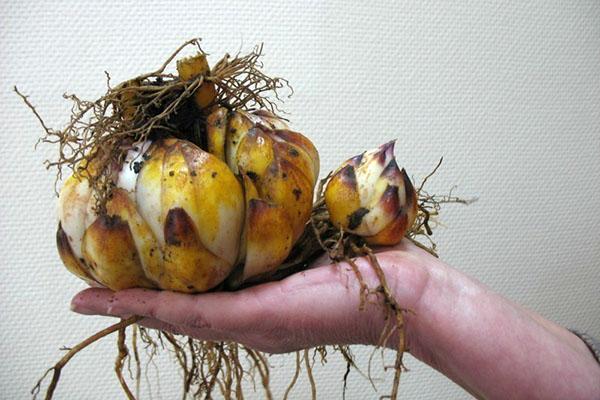Reproduction of lilies by scales: an easy way to breed flowers
 Reproduction of lilies by scales is an uncomplicated vegetative way of growing flowers of the variety you like. In this case, it is possible to get a lot of plants with all the traits and characteristics of the parent specimen.
Reproduction of lilies by scales is an uncomplicated vegetative way of growing flowers of the variety you like. In this case, it is possible to get a lot of plants with all the traits and characteristics of the parent specimen.
Stage-by-stage reproduction of lilies by scales

How to propagate lilies with scales? The optimal time to split the bulb is in autumn, when more than a month has passed since the end of flowering.
This time was not chosen by chance, since it was by autumn:
- the bulbs acquire the necessary hardness;
- a sufficient amount of nutrients accumulates in the bulbs.
An alternative option is to carry out work in the spring. This allows the separated flakes to be planted directly into the open ground.
Stage 1. Flake preparation
 The breeding process begins with digging up the parent bulb. The upper large scales are separated from it, and the remaining onion is returned to the ground, after having previously treated the places of the removed scales with a weak solution of potassium permanganate.
The breeding process begins with digging up the parent bulb. The upper large scales are separated from it, and the remaining onion is returned to the ground, after having previously treated the places of the removed scales with a weak solution of potassium permanganate.
If it is desired to retain the parent bulb, do not remove more than half of the scales from it.
The following actions are performed over the scales:
- Rinse with plain water.
- They are treated with a weak (0.1%) solution of potassium permanganate.
- Treated with a growth stimulating agent.
Pour into a plastic bag peatin which the scales will be placed. It should be slightly damp. If it is too dry, it is necessary to slightly moisten the substrate by sprinkling with water.
 Flakes are placed in peat, evenly distributed. The package is tied and stored in a shed or on a balcony for 15-30 days, until small new bulbs and roots appear on the scales.
Flakes are placed in peat, evenly distributed. The package is tied and stored in a shed or on a balcony for 15-30 days, until small new bulbs and roots appear on the scales.
If there are a lot of varieties in the work, then it is advisable to sign the package with scales.
Stage 2. Planting in soil
 How to propagate lilies further? When good and strong roots appear on young bulbs, they are ready for separation and planting in containers with a soil mixture for further cultivation, deepening 2/3 of the height.
How to propagate lilies further? When good and strong roots appear on young bulbs, they are ready for separation and planting in containers with a soil mixture for further cultivation, deepening 2/3 of the height.
Planting is carried out at a distance of several centimeters from each other (5-6 cm). The distance between the rows should be about 0.2 m. After planting the soil mulch.
 Young lily bulbs can be planted in spring and autumn. But in the latter case, it is necessary to organize covering for the winter with dry leaves and film. The overwintered plants are thinned out in the spring.
Young lily bulbs can be planted in spring and autumn. But in the latter case, it is necessary to organize covering for the winter with dry leaves and film. The overwintered plants are thinned out in the spring.
The soil should not be allowed to dry out until the plants are strong.
Advantages and disadvantages of scale propagation
 The process of reproduction of lilies by separating the scales from the bulb has many important advantages that can become decisive when choosing the reproduction of a flower you like.
The process of reproduction of lilies by separating the scales from the bulb has many important advantages that can become decisive when choosing the reproduction of a flower you like.
Among them:
- Efficiency.
- The cost-effectiveness of the method.
- A large amount of planting material from one bulb.
- Suitable for almost all types of lilies.
- Ease of implementation.
The disadvantages of the method of reproduction of lilies with scales include:
- There is a chance that not all scales will produce new bulbs.
- If you overdo it with the separation of the scales from the mother bulb, you can damage the adult plant.
- Not all new bulbs are accepted.
- Careful care of new bulbs is necessary until they are strong.
The method of propagation of lilies using scales is most indicated for varieties that form very few daughter bulbs.
 Reproduction of lilies by scales separated from the bulb - allows you to get many independent plants that fully inherit all the characteristics of the parent flower. With proper patience, and careful execution of all work, it is possible to get a rich flower garden from your favorite lilies.
Reproduction of lilies by scales separated from the bulb - allows you to get many independent plants that fully inherit all the characteristics of the parent flower. With proper patience, and careful execution of all work, it is possible to get a rich flower garden from your favorite lilies.